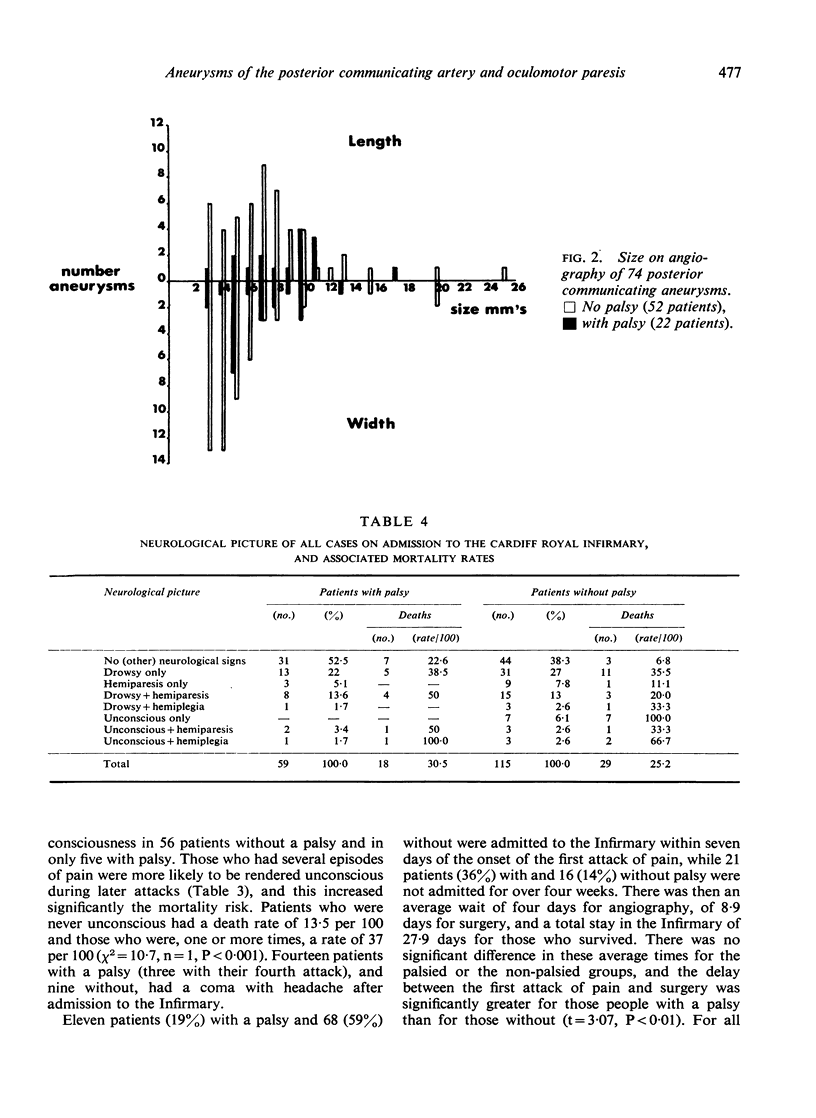Abstract
One hundred and seventy-four patients with a posterior communicating aneurysm were seen over a 21 year period. There was a ratio of four females to one male and women were on average five years older. Fifty-nine (34%) had an oculomotor paresis. This group had up to four attacks of localized headache, large multiloculated aneurysms, and a greater time lapse from the onset of symptoms to surgery compared with those patients without oculomotor palsy. Delay in treatment allowed further attacks to occur which increased the mortality rate and decreased the chance that the eye would recover. Eighteen people who had had a palsy before craniotomy two to 18 years previously were examined. In four (22%) the paralysis had recovered completely, 14 (78%) had greatly reduced oculomotor function, and nine (50%) showed aberrant regeneration of the nerve. Nine of 62 patients, seven of whom were seen, developed a palsy after craniotomy and in five the eye had returned to normal.
Full text
PDF









Images in this article
Selected References
These references are in PubMed. This may not be the complete list of references from this article.
- ALPERS B. J., SCHLEZINGER N. S. Aneurysm of the posterior communicating artery. Arch Ophthal. 1949 Oct;42(4):353–364. doi: 10.1001/archopht.1949.00900050361001. [DOI] [PubMed] [Google Scholar]
- BOTTERELL E. H., LLOYD L. A., HOFFMAN H. J. Oculomotor palsy due to supraclinoid internal carotid artery berry aneurysm. A long-term study of the results of surgical treatments on the recovery of third-nerve function. Am J Ophthalmol. 1962 Oct;54:609–616. doi: 10.1016/0002-9394(62)92191-8. [DOI] [PubMed] [Google Scholar]
- Balla J. I., Morley J. B. Oculomotor nerve paralysis. Med J Aust. 1967 Apr 15;1(15):755–758. doi: 10.5694/j.1326-5377.1967.tb21601.x. [DOI] [PubMed] [Google Scholar]
- Bull J. Massive aneurysms at he base of the brain. Brain. 1969;92(3):535–570. doi: 10.1093/brain/92.3.535. [DOI] [PubMed] [Google Scholar]
- CHEEK C. W., SIMON K. A., GAY A. J. ACQUIRED CRANIAL NERVE LESIONS AFFECTING THE OCULAR SYSTEM. Am J Ophthalmol. 1965 Jan;59:13–17. doi: 10.1016/0002-9394(65)95011-7. [DOI] [PubMed] [Google Scholar]
- COGAN D. G., LINCOFF H. A. Unilateral headache and oculomotor paralysis not caused by aneurysm. AMA Arch Ophthalmol. 1957 Feb;57(2):181–189. doi: 10.1001/archopht.1957.00930050189004. [DOI] [PubMed] [Google Scholar]
- COGAN D. G., MOUNT H. T. INTRACRANIAL ANEURYSMS CAUSING OPHTHALMOPLEGIA. Arch Ophthalmol. 1963 Dec;70:757–771. doi: 10.1001/archopht.1963.00960050759007. [DOI] [PubMed] [Google Scholar]
- Cantu R. C. Oculomotor palsy with posterior communicating artery aneurysm. Outcome with carotid ligation versus medical therapy. Int Surg. 1969 Aug;52(2):144–150. [PubMed] [Google Scholar]
- GREEN W. R., HACKETT E. R., SCHLEZINGER N. S. NEURO-OPHTHALMOLOGIC EVALUATION OF OCULOMOTOR NERVE PARALYSIS. Arch Ophthalmol. 1964 Aug;72:154–167. doi: 10.1001/archopht.1964.00970020154005. [DOI] [PubMed] [Google Scholar]
- HAMILTON J. G., FALCONER M. A. Immediate and late results of surgery in cases of saccular intracranial aneurysms. J Neurosurg. 1959 Sep;16:514–541. doi: 10.3171/jns.1959.16.5.0514. [DOI] [PubMed] [Google Scholar]
- HARRIS P., UDVARHELYI G. B. Aneurysms arising at the internal carotid-posterior communicating artery junction. J Neurosurg. 1957 Mar;14(2):180–191. doi: 10.3171/jns.1957.14.2.0180. [DOI] [PubMed] [Google Scholar]
- HENDERSON J. W. Intracranial arterial aneurysms; a study of 119 cases, with special reference to the ocular findings. Trans Am Ophthalmol Soc. 1955;53:349–462. [PMC free article] [PubMed] [Google Scholar]
- HYLAND H. H., BARNETT H. J. The pathogenesis of cranial nerve palsies associated with intracranial aneurysms. Proc R Soc Med. 1954 Feb;47(2):141–146. doi: 10.1177/003591575404700216. [DOI] [PMC free article] [PubMed] [Google Scholar]
- JAEGER R. Aneurysm of the intracranial carotid artery; syndrome of frontal headache with oculomotor nerve paralysis. J Am Med Assoc. 1950 Feb 4;142(5):304-10, illust. doi: 10.1001/jama.1950.02910230006002. [DOI] [PubMed] [Google Scholar]
- JOHNSTON A. C., PRATT-JOHNSON J. A. THE OCULAR SEQUELAE OF THIRD CRANIAL NERVE PALSY. Can Med Assoc J. 1963 Oct 26;89:871–873. [PMC free article] [PubMed] [Google Scholar]
- KERR F. W., HOLLOWELL O. W. LOCATION OF PUPILLOMOTOR AND ACCOMMODATION FIBRES IN THE OCULOMOTOR NERVE: EXPERIMENTAL OBSERVATIONS ON PARALYTIC MYDRIASIS. J Neurol Neurosurg Psychiatry. 1964 Oct;27:473–481. doi: 10.1136/jnnp.27.5.473. [DOI] [PMC free article] [PubMed] [Google Scholar]
- MADOW L., ALPERS B. J. Aneurysm of the posterior communicating artery; report of five additional cases. AMA Arch Neurol Psychiatry. 1953 Dec;70(6):722–732. doi: 10.1001/archneurpsyc.1953.02320360037004. [DOI] [PubMed] [Google Scholar]
- Paterson A. Direct surgery in the treatment of posterior communicating aneurysms. Lancet. 1968 Oct 12;2(7572):808–811. doi: 10.1016/s0140-6736(68)92460-4. [DOI] [PubMed] [Google Scholar]
- Raja I. A. Aneurysm-induced third nerve palsy. J Neurosurg. 1972 May;36(5):548–551. doi: 10.3171/jns.1972.36.5.0548. [DOI] [PubMed] [Google Scholar]
- Rucker C. W. The causes of paralysis of the third, fourth and sixth cranial nerves. Am J Ophthalmol. 1966 May;61(5 Pt 2):1293–1298. doi: 10.1016/0002-9394(66)90258-3. [DOI] [PubMed] [Google Scholar]
- SUNDERLAND S. Mechanism responsible for changes in the pupil unaccompanied by disturbances of extra-ocular muscle function. Br J Ophthalmol. 1952 Nov;36(11):638–644. doi: 10.1136/bjo.36.11.638. [DOI] [PMC free article] [PubMed] [Google Scholar]
- WALSH F. B. Third nerve regeneration; a clinical evaluation. Br J Ophthalmol. 1957 Oct;41(10):577–598. doi: 10.1136/bjo.41.10.577. [DOI] [PMC free article] [PubMed] [Google Scholar]







